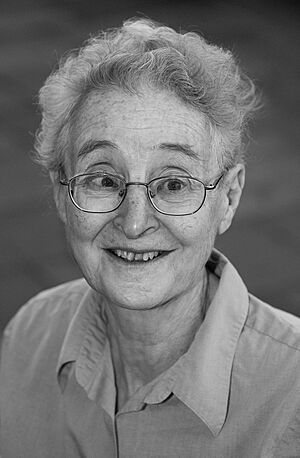Deborah Charlesworth facts for kids
Quick facts for kids
Deborah Charlesworth
|
|
|---|---|
 |
|
| Born |
Deborah Maltby
13 March 1943 |
| Citizenship | British |
| Alma mater | University of Cambridge |
| Spouse(s) | |
| Children | 1 daughter |
| Awards |
|
| Scientific career | |
| Fields | Evolutionary biology |
| Institutions |
|
| Thesis | Biometrical studies of some biochemical characters in the mouse (1969) |
| Doctoral students | Philip Awadalla |
| Other notable students | Gilean McVean (postdoc) |
Deborah Charlesworth is a famous scientist from the UK who studies population genetics. This means she looks at how the genes of a whole group of plants or animals change over many generations. She is known for her important discoveries in how plants and animals evolve.
Her most famous work is about how plants reproduce. She studied how plants avoid mating with themselves and why sex chromosomes (like the X and Y chromosomes in humans) evolved. She also researched how DNA gets shuffled between chromosomes to create new genetic combinations.
Contents
Early Life and Schooling
Deborah Charlesworth was born in 1943 and grew up near London. From a young age, she was very curious about nature and the world around her.
She went to the University of Cambridge and first studied biochemistry, which is the chemistry of living things. But she quickly became interested in genetics. For her final project to earn her doctorate degree in 1968, she studied mice. She looked at how their genes caused differences in their blood sugar levels.
A Career in Science
After finishing her studies, Charlesworth continued her research at several universities, including Cambridge and the University of Chicago. At first, she studied small differences in human blood proteins.
A Shift to Evolution
Her interest in evolutionary biology grew when she started working with her husband, Brian Charlesworth, who is also a famous scientist. They studied how some animals evolve to look like other, more dangerous animals to protect themselves. This work led her to focus completely on evolution.
For many years, she did her research without getting paid for it. She moved to different universities as her husband got new jobs, and she continued her important work on her own.
Becoming a Professor
In 1988, when she was 45 years old, Charlesworth got her first official teaching job as a professor at the University of Chicago. By then, she had already written about 50 scientific articles! Later, she became a special research professor at the University of Edinburgh.
She is most famous for her work on how some plants have a genetic system to stop them from pollinating themselves. This is called "self-incompatibility." This system is important because it makes sure plants mix their genes with other plants, which helps the species stay healthy and diverse.
Deborah Charlesworth is a very respected scientist. She has written over 300 articles for science journals. Other scientists have mentioned her work in their own articles more than 10,000 times, showing how important her ideas are.
Awards and Achievements
Deborah Charlesworth's amazing work has earned her many top awards.
- In 2001, she was elected a Fellow of the Royal Society of Edinburgh.
- In 2005, she became a Fellow of the Royal Society (FRS), one of the highest honors for a scientist in the UK.
- In 2011, she received the Molecular Ecology Prize for her research.
- In 2019, she was awarded the Genetics Society Medal.
- In 2020, she received a Lifetime Achievement Award from the Society for the Study of Evolution.
- In 2022, she was elected to the National Academy of Sciences in the United States, another very high honor.
See also
 In Spanish: Deborah Charlesworth para niños
In Spanish: Deborah Charlesworth para niños

